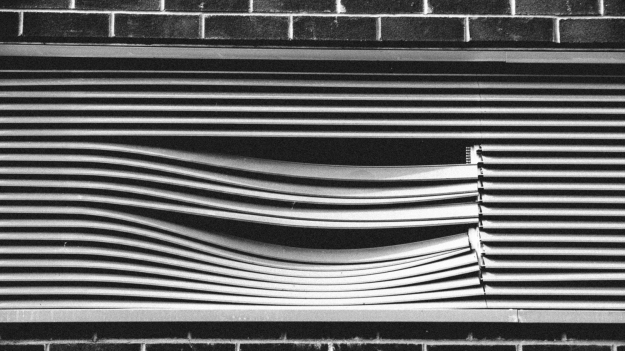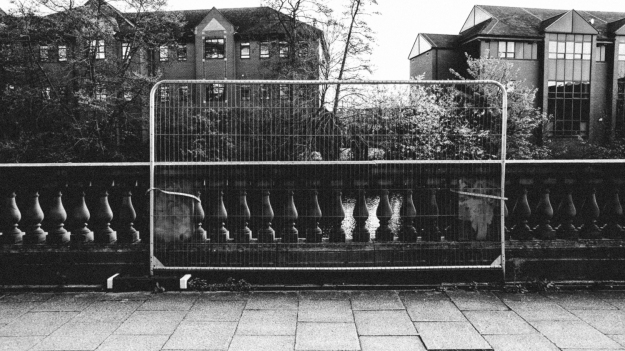This exercise requires me make a list of some unique aspects of my personality then set about expressing these attributes through a photograph.
I noted that the exercise does not use the word ‘portrait’ on this occasion.
I reflected on a few ideas then went for a walk around the city of Derby. I opted for a gritty black and white aesthetic to echo the darker, more melancholy, shadow-self that resides below the happy, cheerful persona that other people identify with as being ‘Ian’:
 There is a constant conflict within me of wanting structure and order vs. seeking a simpler, less structured life where random fun things happen.
There is a constant conflict within me of wanting structure and order vs. seeking a simpler, less structured life where random fun things happen.
After taking this I also considered that there’s a voyeuristic element to this image – as though a person unknown is watching me through a venetian blind. I fear our gradual loss of civil liberties caused by CCTV, internet surveillance, and so on as we cannot be assured that those watching us always have good intent.
 This image describes me on two levels. I love to be alone in nature, especially near trees and water. Despite being in the centre of a busy city this rower have found his own quiet space, the image framed to exclude the surrounding buildings and bridges.
This image describes me on two levels. I love to be alone in nature, especially near trees and water. Despite being in the centre of a busy city this rower have found his own quiet space, the image framed to exclude the surrounding buildings and bridges.
Like me, he’s seeking to enjoy a journey as much as the achievement of the destination. No competitiveness, no challenge. Just being, moving, travelling.

Is this graffiti reflecting my nature of wanting to help and support people? Or is it a mirror, reminding me how often I don’t do this?

I’m easily discouraged by obstacles. I’m trying to learn to step back and see the way around them.
I feel very inspired to develop this into a body of work and, for this reason alone, has been excellent at helping me out of a bit of a rut. Compared to previous OCA courses I am finding the portraiture in I+P to be more challenging, so it was good to be ‘let off the portraiture leash’ for a while and take photos I enjoy again.
My idea is to consider developing this to see how this mirror of self, portrayed through inanimate objects, changes over time. Perhaps a photobook over a year. Like keeping a written journal but containing photographs. It will be fascinating to see how feelings, mood, style and environment work together and evolve over a period of time. I need to be careful to ensure that this introspective self indulgence doesn’t become all consuming though. While I adore the work of Francesca Woodman, things didn’t end up well for her, as we know. There are also aspects of the self-exploration into the troubled life of Claude Cahun here, as already explored in detail by Gillian Wearing: https://wordpress.com/post/ian513626photography1iandp.wordpress.com/1436
Often a fan of bold ‘Martin Parr like’ primary colours and implied humour, it was interesting to explore this darker side of self. I believe we all have one inside us. Hopefully the viewer would feel that they knew something of my personal journey when they reached the end of it. Although it should really be a personal journal that triggers other ideas and thoughts. My tutor has encouraged the use of a paper-based photo scrapbook and journal for this purpose so I will combine the two some how. I note that some people engage on ‘Project 365’ and ‘Photo a Day’ projects.
